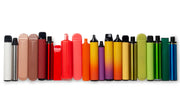
In the evolving world of vaping, consumers are often faced with a choice between disposable vapes and rechargeable vapes. Both options offer a unique set of features and benefits that cater to different preferences and needs.
In this comprehensive guide, we will explore the differences, advantages, and disadvantages of each type, ultimately helping you make an informed decision about which is better for your vaping experience.
Understanding Disposable Vapes
Disposable vapes are designed for single-use, making them a popular choice for casual users and individuals new to vaping.
These devices come pre-filled with e-liquid and are equipped with a fully charged battery. Once the e-liquid is depleted, the entire device is disposed of.
Key Features of Disposable Vapes
One of the most major advantages of disposable vapes is their simplicity. Users may start vaping instantly without the need for complex setups or maintenance.
The tiny form and lightweight nature of disposable devices make them incredibly portable, allowing users to carry them simply and enjoy them discreetly.
Disposable vapes often provide a selection of flavors, appealing to varied preferences.
This diversity allows people to experiment with diverse experiences without a large commitment to one single flavor or brand.
Additionally, disposable vapes might be more economical upfront as they don’t require the purchase of additional accessories or settings.
Pros of Disposable Vapes
- Convenience: Easy to use, with no setup required.
- Portability: Lightweight and compact, perfect for on-the-go use.
- Variety: Wide range of flavors and options available.
- No Maintenance: Once it's finished, simply dispose of it.
Cons of Disposable Vapes
- Cost Over Time: While the initial cost is low, frequent purchases can add up.
- Environment Impact: Increased waste due to disposability.
- Limited Lifespan: Once the e-liquid is used, the vape is no longer usable.
Exploring Rechargeable Vapes
Rechargeable vapes, also known as reusable vapes, offer a more sustainable option for those who vape regularly.
These devices consist of a rechargeable battery and a tank or pod that can be filled with e-liquid of the user’s choice.
Key Features of Rechargeable Vapes
One of the main advantages of rechargeable vapes is their sustainability. Users can refill the e-liquid and recharge the battery multiple times, reducing waste associated with disposable devices.
This makes rechargeable vapes not only more economical in the long run but also more favorable for environmentally conscious consumers.
Rechargeable vapes often provide a more customizable experience. Users can choose their preferred e-liquid flavor, nicotine strength, and even the type of device they want to use.
Furthermore, many rechargeable vapes come equipped with advanced features such as adjustable wattage, temperature control, and customizable airflow, allowing for a more tailored vaping experience.
Read: The Benefits of Vaping HHC You Should Know
Pros of Rechargeable Vapes
- Cost-Effective: Long-term savings as users can refill and recharge multiple times.
- Eco-Friendly: Reduced waste and environmental impact.
- Customizable Experience: Users have control over flavor, nicotine level, and device settings.
- Advanced Features: Many devices offer technology that enhances the vaping experience.
Cons of Rechargeable Vapes
- Complexity: May require more initial knowledge or setup.
- Maintenance Required: Need for regular cleaning and e-liquid refilling.
- Bulkier: Generally less portable compared to disposable vapes.
Comparing Usage and Experience
When it comes to user experience, disposable and rechargeable vapes cater to different needs and lifestyles.
For Casual Users
Individuals who vape sometimes or are new to vaping may find disposable vapes more enticing.
The simplicity of usage and low barrier to entry make them an enticing alternative.
Casual users may enjoy testing numerous tastes without committing to a more serious investment in hardware.
For Frequent Users
On the other hand, folks who vape often may benefit more from rechargeable vapes.
The long-term savings associated with replenishing e-liquids and recharging batteries can make a considerable difference for heavy users.
Moreover, the option to adjust flavors and settings increases the whole experience for people who are serious about vaping.
Cost Analysis: Disposable vs. Rechargeable Vapes
When considering the cost difference between disposable and rechargeable vapes, we must account both short-term and long-term costs.
Initial Costs
Disposable vapes often have a reduced starting cost. A single disposable vape can cost from $5 to $15, depending on brand and size.
In comparison, rechargeable vapes sometimes demand a greater initial cost.
Users need to purchase the device itself, which can range from $20 to over $100, coupled with the cost of e-liquids.

How Long for THC Vape Pen to Hit: Understanding Onset Times
The popularity of THC vape pens has surged as cannabis enthusiasts seek more efficient and discreet methods of consumption. However, a common question among users—both new and experienced—is, "How long does it take for a THC vape pen to hit?" Understanding the onset time will substantially increase your vaping experience, helping you regulate your intake correctly and attain the intended benefits.
How THC Works in the Body
When breathed, THC (Tetrahydrocannabinol) enters the circulation swiftly through the lungs. This quick absorption is one of the key reasons many users choose vaping over other consuming techniques.
The effects of THC are felt nearly immediately, while numerous circumstances contribute to the particular timing of these effects.
The Onset Time of THC from Vaping
Generally, users may anticipate to feel the effects of vaping THC within a short duration following inhalation. Most studies indicate that the effects will begin to kick in within minutes, often between 2 to 10 minutes.
This speedy onset is one of the enticing characteristics of utilising vape pens for cannabis ingestion.
The instant impacts can generate a feeling of urgency in recognising personal tolerance levels and the strength of the substance being taken, since the quick impact might lead to undesired results if consumers are ignorant.
Factors Influencing How Long THC Takes to Hit
Method of Inhalation
The method one inhales THC might determine how fast the effects are perceived. Taking deep, extended puffs vs short, fast inhales might impact how soon THC reaches the bloodstream.
Longer inhales may result in a speedier start of effects, while rapid puffs may extend the experience.
Concentration of THC in the Vape Pen
Different vape pens contain variable quantities of THC. More stronger formulations can lead to more immediate and intense effects.
Users should constantly check the product label for THC levels and regulate their consumption accordingly.
Individual Metabolism
Metabolism has a crucial effect in how rapidly THC affects the body. Factors such as age, weight, gender, and metabolic rate might vary greatly across users and contribute to the overall experience.
Individuals with faster metabolisms may experience the impacts more swiftly than those with sluggish metabolisms.
Tolerance Levels
Frequent users of THC may acquire a tolerance over time. This implies that they may not feel the affects as sharply or as rapidly as occasional users.
Understanding your personal tolerance is vital when considering how long it may take for you to feel the effects of a THC vape pen.
Settings and Environment
The setting in which you take THC might also have an affect. A relaxing atmosphere might increase the benefits, whereas a stressful or distracted situation may lead to delayed detection of the effects.
Understanding the Full Spectrum of Effects
After initially feeling the effects of THC, users should expect a spectrum of emotions that build over time. The complete experience frequently encompasses many aspects, including the beginning, peak, and longevity.
Onset Phase
As noted, the beginning phase occurs within minutes after inhalation. Users may first feel a sensation of exhilaration or relaxation.
It’s vital to be aware during this early stage, since the fast onset may occasionally lead to overconsumption if one does not wait long enough before taking another dosage.
Peak Effects
The greatest effects of vaping THC generally occur 30 minutes to an hour after inhalation. During this period, users may feel heightened sensory awareness, increased hunger, and enhanced mood.
Duration of Effects
The length of effects can last anywhere from one to three hours, depending on factors like as dose, individual tolerance, and the intensity of the vape oil used.
After the peak effects subside, individuals may have lingering effects for extra hours.
Best Practices for Vaping THC
To achieve a great vaping experience and precisely assess how long it takes for a THC vape pen to hit, it’s crucial to follow best practices.
Start Low and Go Slow
For novice users or those trying a new strain or brand, starting with modest dosages and gradually increasing the quantity is suggested. This strategy helps you to learn how your body reacts to THC.
Give It Time
After your initial dose, let at least 10 to 15 minutes before taking another smoke. This waiting period enables you examine the early effects without overconsuming.
Stay Hydrated
Vaping can lead to dehydration, which may increase some negative effects. Drink water before and after usage to guarantee a comfortable experience.
Choose Quality Products
Select trustworthy manufacturers and guarantee that the THC vape pen or oil you buy undergoes laboratory testing. Quality goods are more likely to give correct dosage and predictable outcomes.
Maintain a Positive Environment
Ensure that your vaping experience takes place in a pleasant atmosphere. A good setting can boost the overall impact and help you thoroughly enjoy your session.











